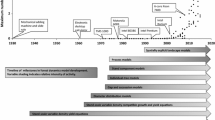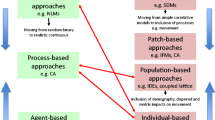Abstract
Researchers and natural resource managers need predictions of how multiple global changes (e.g., climate change, rising levels of air pollutants, exotic invasions) will affect landscape composition and ecosystem function. Ecological predictive models used for this purpose are constructed using either a mechanistic (process-based) or a phenomenological (empirical) approach, or combination. Given the accelerating pace of global changes, it is becoming increasingly difficult to trust future projections made by phenomenological models estimated under past conditions. Using forest landscape models as an example, I review current modeling approaches and propose principles for developing the next generation of landscape models. First, modelers should increase the use of mechanistic components based on appropriately scaled “first principles” even though such an approach is not without cost and limitations. Second, the interaction of processes within a model should be designed to minimize a priori constraints on process interactions and mimic how interactions play out in real life. Third, when a model is expected to make accurate projections of future system states it must include all of the major ecological processes that structure the system. A completely mechanistic approach to the molecular level is not tractable or desirable at landscape scales. I submit that the best solution is to blend mechanistic and phenomenological approaches in a way that maximizes the use of mechanisms where novel driver conditions are expected while keeping the model tractable. There may be other ways. I challenge landscape ecosystem modelers to seek new ways to make their models more robust to the multiple global changes occurring today.
Similar content being viewed by others
References
Aber JD, Ollinger SV, Federer CA, Reich PB, Goulden ML, Kicklighter DW, Mellilo JM, Lathrop RG (1995) Predicting the effects of climate change on water yield and forest production in the northeastern US. Clim Change Res 5:207–222
Allen TFH, Hoekstra TW (1992) Toward a unified ecology. Columbia University, New York
Berliner LM (2003) Physical-statistical modeling in geophysics. J Geophys Res. doi:10.1029/2002JD002865
Boose ER, Chamberlin KE, Foster DR (2001) Landscape and regional impacts of hurricanes in New England. Ecol Monogr 71:27–48
Botkin DB, Janak JF, Wallis JR (1972) Some ecological consequences of a computer model of forest growth. J Ecol 60:849–873
Bugmann H, Lindner M, Lasch P, Flechsig M, Ebert B, Cramer W (2000) Scaling issues in forest succession modeling. Clim Change 44:265–289
Chew JD, Stalling C, Moeller K (2004) Integrating knowledge for simulating vegetation change at landscape scales. W J Appl For 19:102–108
Crookston NL, Dixon GE (2005) The forest vegetation simulator: a review of its structure, content, and applications. Comp Electron Agric 49:60–80
Cuddington K, Fortin M-J, Gerber LR, Hastings A, Liebhold A, O’Connor M, Ray C (2013) Process-based models are required to manage ecological systems in a changing world. Ecosphere 4:20 http://dx.doi.org/10.1890/ES12-00178.1
Cullingham CI, Cooke JEK, Dang S, Davis CS, Cooke BJ, Coltman DW (2011) Mountain pine beetle host-range expansion threatens the boreal forest. Mol Ecol 20:2157–2171. doi:10.1111/j.1365-294X.2011.05086.x
Cushman SA, McKenzie D, Peterson DL, Littell J, McKelvey KS (2007) Research agenda for integrated landscape modeling. USDA Forest Service Gen. Tech. Rep. RMRS-194. Rocky Mountain Research Station, Fort Collins
Cushman S, Tzeidle A, Wasserman N, McGarigal K (2011) Modeling landscape fire and wildlife habitat. In: McKenzie D, Miller C, Falk DA (eds), The landscape ecology of fire, Ecological Studies 213, Springer, New York, p 223–245 doi 10.1007/978-94-007-0301-8_9
De Bruijn AMG, Gustafson EJ, Sturtevant B, Jacobs D (in prep) Merging PnET and LANDIS-II to model succession: mechanistic simulation of competition for water and light to project landscape forest dynamics. Ecol Modelling
Ek AR, Monserud RA (1974) FOREST: computer model for the growth and reproduction simulation for mixed species forest stands. Research Report A2635, College of Agricultural and Life Sciences, University of Wisconsin, Madison
Friend AD, Schugart HH, Running SW (1993) A physiology-based model of forest dynamics. Ecology 74:792–797
Fries J (ed) (1974) Growth models for tree and stand simulation. Research Notes 30. Royal College of Forestry, Stockholm, p 397
Grumbine RE (1994) What is Ecosystem Management? Cons Biol 8:27–38
Gustafson EJ, Crow TR (1996) Simulating the effects of alternative forest management strategies on landscape structure. J Environ Manage 46:77–94
Gustafson EJ, Shvidenko AZ, Sturtevant BR, Scheller RM (2010) Predicting global change effects on forest biomass and composition in south-central Siberia. Ecol Appl 20:700–715
He HS (2008) Forest landscape models: definitions, characterization, and classification. For Ecol Manage 254:484–498
IPCC (2007) Climate change 2007: the physical science basis. In: Solomon S, Qin D, Manning M, Chen Z, Marquis M, Averyt KB, Tignor Miller MHL (eds) Contribution of working group I to the fourth assessment report of the intergovernmental panel on climate change. Cambridge University, Cambridge
Johnson KN (1992) Consideration of watersheds in long-term forest planning models: the case of FORPLAN and it use on the national forests. In: Naiman RJ (ed) Watershed management: balancing sustainability and environmental change. Springer, New York, pp 347–360
Keane RE, Arno SF, Brown JK (1989) FIRESUM—an ecological process model for fire succession in western conifer forests. USDA Forest Service Gen. Tech. Rep. INT-266. Intermountain Research Station, Ogden
Keane RE, Holsinger LM, Pratt SD (2006) Simulating historical landscape dynamics using the landscape fire succession model LANDSUM version 4.0. USDA Forest Service General Tech Rep RMRS-171CD. Rocky Mountain Research Station, Fort Collins
Keane RE, Holsinger LM, Parsons RA, Gray K (2008) Climate change effects on historical range and variability of two large landscapes in western Montana, USA. For Ecol Manage 254:375–389
Keane RE, Loehman RA, Holsinger LM (2011) The FireBGCv2 landscape fire and succession model: a research simulation platform for exploring fire and vegetation dynamics. USDA Forest Service Gen. Tech. Rep. RMRS-255. Rocky Mountain Research Station, Fort Collins
Keane RE, Miller C, Smithwick E, McKenzie D, Falk D, Kellogg L (in review) Representing climate, disturbance, and vegetation interactions in landscape simulation models. Ecol Modelling
Kennedy MC, Ford ED (2011) Using multicriteria analysis of simulation models to understand complex biological systems. Bioscience 61:994–1004
Kimmins JP, Blanco JA (2011) Issues facing forest management in Canada, and predictive ecosystem management tools for assessing possible futures. In: Li C, Lafortezza R, Chen J (eds) Landscape ecology in forest management and conservation. Higher Education Press/Springer, Bejing/Berlin, pp 46–72
Kimmins JP, Blanco JA, Seely B, Welham C, Scoullar K (2008) Complexity in modeling forest ecosystems: how much is enough? For Ecol Manage 256:1646–1658
Korzukhin MD, Ter-Mikaelian MT, Wagner RG (1996) Process versus empirical models: which approach for forest ecosystem management? Can J For Res 26:879–887
McGarigal K, Romme WH (2012) Modeling historical range of variation at a range of scales: example application. In: Wiens J, Regan C, Hayward G, Safford H (eds) Historical environmental variation in conservation and natural resource management. Wiley, New York, pp 128–145
Mladenoff DJ (2004) LANDIS and forest landscape models. Ecol Modelling 180:7–19
Mladenoff DJ, Baker WL (1999) Development of forest and landscape modeling approaches. In: Mladenoff DJ, Baker WL (eds) Spatial modeling of forest landscape change: approaches and applications. Cambridge University, Cambridge UK, pp 1–13
Parslow J, Cressie N, Campbell EP, Jones E, Murray L (2013) Bayesian learning and predictability in a stochastic nonlinear dynamical model. Ecol Appl 23:679–698
Perera AH, Yemshanov D, Schnekenburger F, Baldwin DJB, Boychuk D, Weaver K (2004) Spatial simulation of broad-scale fire regimes as a tool for emulating natural forest landscape disturbance. In: Perera AH, Buse LJ, Weber MG (eds) Emulating natural forest landscape disturbances: concepts and applications. Columbia University, New York, pp 112–122
Risser PG, Iverson LR (2013) 30 years later—landscape ecology: directions and approaches. Landscape Ecol 28:367–369
Running SW, Coughlan JC (1988) A general model of forest ecosystem processes for regional applications I. Hydrologic balance, canopy gas exchange and primary production processes. Ecol Modelling 42:125–154
Running SW, Hunt ER Jr (1993) Generalization of a forest ecosystem process model for other biomes, BIOME-BGC, and an application for global-scale models. In: Ehleringer JR, Field CB, Roy J (eds) Scaling physiological processes: leaf to globe. Academic Press, San Diego, pp 141–157
Scheller RM, Mladenoff DJ (2004) A forest growth and biomass module for a landscape simulation model, LANDIS: design, validation, and application. Ecol Modelling 180:211–229
Scheller RM, Mladenoff DJ (2007) An ecological classification of forest landscape simulation models: tools and strategies for understanding broad-scale forested ecosystems. Landscape Ecol 22:491–505
Schulte LA, Mladenoff DJ (2005) Severe wind and fire regimes in northern forests; historical variability at the regional scale. Ecology 86:431–445
Shugart HH, Woodward FI (2011) Global change and the terrestrial biosphere: achievements and challenges. Wiley–Blackwell, Oxford UK 242 p
Shugart HH Jr, Crow TR, Hett JM (1973) Forest succession models: a rationale and methodology for modeling forest succession over large regions. For Sci 19:203–212
Suffling R, Perera AH (2004) Characterizing natural forest disturbance regimes. In: Perera AH, Buse LJ, Weber MG (eds) Emulating natural forest landscape disturbances: concepts and applications. Columbia University, New York, pp 43–54
Turner MG (2005) Landscape ecology in North America: past present, and future. Ecology 86:1967–1974
Urban DL, O’Neill RV, Shugart HH Jr (1987) Landscape ecology. Bioscience 37:119–127
Urban DL, Bonan GB, Smith TM, Schugart HH (1991) Spatial applications of gap models. For Ecol Manag 42:95–110
Acknowledgments
I thank Brian Sturtevant, Robert Scheller, David Mladenoff, Robert Keane, Kevin McGarigal, Ajith Perera and three anonymous reviewers for insightful comments and perspectives that greatly helped to clarify my thinking and presentation.
Author information
Authors and Affiliations
Corresponding author
Rights and permissions
About this article
Cite this article
Gustafson, E.J. When relationships estimated in the past cannot be used to predict the future: using mechanistic models to predict landscape ecological dynamics in a changing world. Landscape Ecol 28, 1429–1437 (2013). https://doi.org/10.1007/s10980-013-9927-4
Received:
Accepted:
Published:
Issue Date:
DOI: https://doi.org/10.1007/s10980-013-9927-4




